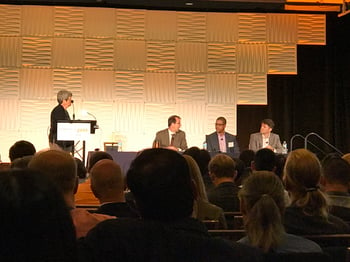 Last month, Leonardo's Key Account Manager for Automotive Lidar attended the Automated Vehicles Symposium in San Francisco, led by the Association of Unmanned Vehicle Systems International (AUVSI) and the Transportation Research Board, part of the National Academies of Sciences, Engineering, and Medicine (NASEMTRB).This symposium afforded Leonardo the opportunity to better understand market outlook, and how the laser solutions team’s lidar source technology can impact this market. Here’s our review on the show, and some questions that remain:
Last month, Leonardo's Key Account Manager for Automotive Lidar attended the Automated Vehicles Symposium in San Francisco, led by the Association of Unmanned Vehicle Systems International (AUVSI) and the Transportation Research Board, part of the National Academies of Sciences, Engineering, and Medicine (NASEMTRB).This symposium afforded Leonardo the opportunity to better understand market outlook, and how the laser solutions team’s lidar source technology can impact this market. Here’s our review on the show, and some questions that remain:
Who attended?
- Tier 1 automotive suppliers (Continental)
- Government agencies (State and Federal DoT)
- Hardware and software providers (Velodyne, Quanergy, Baidu)
- Ride sharing service providers (Lyft, Uber)
- Auto manufacturers
Is there still more for us to learn about autonomous vehicles?
A few key areas of exploration remain:
- What is the correct mix of technology that will be needed out of HD Maps for roads—lidar, radar, smart roads, other sensors, V2X car-to-car communication (either Wi-Fi 802.11p or 5G C-V2X)?
- The importance of cybersecurity and how to address it.
- How smart will roads have to be? Especially for special cases like road construction or repair, often times the cars will have to “break” the rules of the road to get through construction such as crossing double lines to get around an obstruction.
Is lidar technology the answer for autonomous driving?
Lidar technology is definitely an essential and important piece to the entire autonomous system. Lidar products have higher resolution than radar, and can even create three-dimensional images of foreground images. Its applications involve mapping, driver assistance and self-driving. Our recent blog on lidar by the numbers explores the projected impact of lidar technology in autonomous driver assistance systems.
What speakers did you find most impactful?
The government agencies that have created test areas in their state for commercial R&D. It was refreshing to see proactive thinking on ideas such as smart roads and regulation. Agencies that stood out in particular were the Colorado Department of Transportation, City of Los Angeles DoT and World Economic Forum on the City of Boston. Without the government’s help, autonomous vehicles cannot succeed.
Where does the adoption level seem to stand?
Business leaders and agencies are still not sure if and how long it will take consumers to accept and adopt the technology. A constant theme was that consumers are more willing to forgive human mistakes in car accidents, but will not be so forgiving of machine mistakes. Some were also thinking that the death toll for car accidents would have to be zero for consumer adoption. Also, one speaker addressed this concern, asking, “Have car technology companies designed proper human interfaces to the technologies for easy adoption?”
There may also be fewer cars on the road overall, so state and city agencies are hoping to get some roads back to use for other purposes.
What needs to happen still before autonomous vehicles become commonplace?
Advancement in technology, such as lidar resolution and HD mapping with daily updates in particular. Also, we must see a larger implementation of smart roads.
Want more on the technology behind autonomous vehicles? Download our white paper, The Race to the Starting Line: Edge Emitting Diode Lasers vs. VCSELs for the Automotive Lidar Market.


